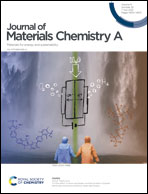Ultrafast fabrication of organohydrogels with UV-blocking, anti-freezing, anti-drying, and skin epidermal sensing properties using lignin–Cu2+ plant catechol chemistry†
Abstract
Rapid fabrication of organohydrogels at room temperature without external stimuli is a challenge. Inspired by plant catechol chemistry, a self-catalytic system established using sodium lignosulfonate and copper(II) ions (Ls–Cu2+) has been developed and applied to fabricate organohydrogels rapidly with fascinating multifunctional properties. The Ls–Cu2+ pair can induce ammonium persulfate (APS) to generate free radicals at room temperature, and subsequently initiate the free radical polymerization of hydroxyethyl acrylamide (HEAA) in water–glycerol binary phases in less than 30 s, without the removal of oxygen. The presence of the Ls–Cu2+ pair also endows the organohydrogel materials with fascinating UV-blocking (∼100%) and electrically conductive properties, and thereby they can be exploited as epidermal sensors. Owing to the presence of glycerol, the as-prepared organohydrogel exhibits intriguing anti-freezing (∼−50 °C) and anti-drying abilities (22–60 °C). This work taps the potential of dynamic plant catechol chemistry in the field of organohydrogel materials.



 Please wait while we load your content...
Please wait while we load your content...